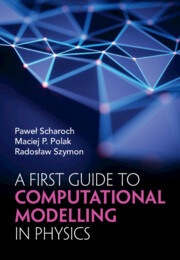Book contents
- Frontmatter
- Contents
- Preface
- How to Use the Book
- First Steps
- Project 1: Rectangular Finite Quantum Well – Stationary Schrödinger Equation in 1D
- Project 2: Diffraction of Light on a Slit
- Project 3: Pendulum as a Standard of the Unit of Time
- Project 4: Planetary System
- Project 5: Gravitation inside a Star
- Project 6: Normal Modes in a Cylindrical Waveguide
- Project 7: Thermal Insulation Properties of a Wall
- Project 8: Cylindrical Capacitor
- Advanced Projects
- Project 9: Coupled Harmonic Oscillators
- Project 10: The Fermi–Pasta–Ulam–Tsingou Problem
- Project 11: Hydrogen Star
- Project 12: Rectangular Quantum Well Filled with Electrons – The Idea of Self-Consistent Calculations
- Project 13: Time Dependent Schrödinger Equation
- Project 14: Poisson’s Equation in 2D
- Appendix A: Supplementary Materials
- Further Reading
- Index
Project 14: - Poisson’s Equation in 2D
Published online by Cambridge University Press: 01 February 2024
- Frontmatter
- Contents
- Preface
- How to Use the Book
- First Steps
- Project 1: Rectangular Finite Quantum Well – Stationary Schrödinger Equation in 1D
- Project 2: Diffraction of Light on a Slit
- Project 3: Pendulum as a Standard of the Unit of Time
- Project 4: Planetary System
- Project 5: Gravitation inside a Star
- Project 6: Normal Modes in a Cylindrical Waveguide
- Project 7: Thermal Insulation Properties of a Wall
- Project 8: Cylindrical Capacitor
- Advanced Projects
- Project 9: Coupled Harmonic Oscillators
- Project 10: The Fermi–Pasta–Ulam–Tsingou Problem
- Project 11: Hydrogen Star
- Project 12: Rectangular Quantum Well Filled with Electrons – The Idea of Self-Consistent Calculations
- Project 13: Time Dependent Schrödinger Equation
- Project 14: Poisson’s Equation in 2D
- Appendix A: Supplementary Materials
- Further Reading
- Index
Summary
This chapter focuses on the project of finding the potential for a given distribution of charges in a two-dimensional system, which does not possess any symmetrical properties, an extension of the cylindrical potential problem discussed in the previous chapter. Using a method of minimising a functional, specifically the Gauss–Seidel method of iterative minimisation, the Poisson’s equation is adjusted to a 2D case, neglecting one partial derivative in Cartesian coordinates. We subsequently derive a discretised form of the functional, leading to a multi-variable function, following which the problem can be solved using the Gauss–Seidel iterative method. The numerical method discussed here is the finite elements method (FEM), with an emphasis on the need for a specific sequence for updating values to optimise computation efficiency. The discussion sheds light on the importance of the uniqueness of solutions in electrostatic systems, thereby exploring a fundamental question in electrostatics. The concluding part of the chapter provides an outline of a numerical algorithm for the problem, suggesting potential modifications and points for further exploration.
Keywords
- Type
- Chapter
- Information
- A First Guide to Computational Modelling in Physics , pp. 86 - 91Publisher: Cambridge University PressPrint publication year: 2024



